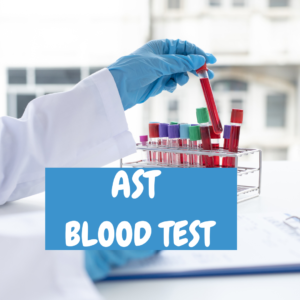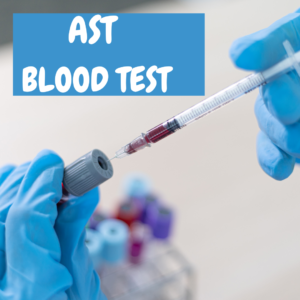What is aspartate transferase (AST)?
Also known as aspartate aminotransferase, AST test (Aspartate transferase) is an enzyme found in the liver, heart, muscle, brain, kidneys, pancreas, and many body tissues. AST is most commonly associated with liver health, although is found throughout the body.
A type of protein in cells that act as catalysts, allowing certain bodily processes to occur is called an enzyme. The body has thousands of different enzymes that have important functions.
What is the AST test?
Aspartate aminotransferase (AST) is an enzyme also found in muscles and other organs of the body but mainly in the liver. Cells that contain AST release AST into the blood when they are damaged. A measure of the amount of AST in the blood is determined with an AST test. Liver disease or damage are commonly diagnosed with an AST test.
Other names: Aspartate transaminase test; serum glutamic acid oxaloacetic transaminase test, SGOT test.
What is the purpose of an AST test?

Cell damage is detected with a blood test measuring AST. In most cases, AST test can explain other health problems but mainly helps assess the condition of the liver.
AST test depending on the situation is usually combined with other test measurements in a panel test, where it helps as a form of medical monitoring, diagnosis, or screening:
Screening:
A medical term for a test in which there are no symptoms of the disease is called screening. If you have liver disease risk factors, such as obesity, excessive alcoholism, diabetes, or a family history of liver problems, then a screening test that includes AST may be prescribed. AST can also be tested at the CMP during routine health checks.
Diagnosis:
It is the process of finding the cause of disease that occurs after the onset of symptoms. For instance, AST may be measured if you have unexplained weight loss, fatigue, jaundice, swelling, itching, vomiting and nausea, or other symptoms related to liver problems.
Monitoring:
A medical term that defines the steps taken to see how your health condition is evolving. Sometimes, to monitor the health of your liver, you will have a periodic AST test. AST can be measured to determine the effectiveness of treatment for liver problems. If you start taking a drug that has the potential to affect your liver, then AST panel test can also help detect signs of liver damage.
Why you should do an AST test?

You may have an AST test if you have symptoms of liver damage or as part of a routine checkup. These includes:
- Loss of appetite
- Vomiting and nausea
- Swollen ankles and feet
- Light-colored stools (faeces) and/or Dark urine (pee)
- Consistent itches
- Fatigue
- Weakness
- Jaundice, a condition that causes the eyes and skin to turn yellow
- Pain and/or Swelling in the belly (abdomen)
If you're more likely to have liver disease even if you don't have symptoms, your doctor may order an AST blood test due to:
- Diabetes
- Consuming medicines that can result to liver disorder
- Contact with hepatitis or Hepatitis
- Family liver disease history
- Alcohol use disorder
- Obesity
What happened during an AST test?

You will be seated up when you go to have your blood drawn, and to increase blood flow in that arm; an elastic band will be tightly tied around your upper arm. The lab technician then insert a needle into the vein to collect a vial of blood after cleaning the puncture site with an antiseptic.
The needle is withdrawn after drawing the required amount of blood. The entire process is usually completed within minutes. Needle sticks can cause stings or even other pain.
For a home test, you must read and follow the instructions in your AST test kit. In most cases, prick your finger with the small needle that comes with the kit after using an antiseptic to clean your fingertip. A blood drop is then placed on a special AST test card, which is then sealed and mailed.
What are some AST test risks?
Blood draw has few risks. The size of blood vessels varies from person to person and from one side of the body to the other. Some people may find it more difficult with the process of drawing their blood than others.
There are few risks associated with having your blood drawn and may include:
- Dizziness or fainting
- Heavy bleeding
- Several punctures to find the vein.
- Blood clot under the skin (Hematoma)
- Small risk of infection with skin puncture.
What do AST test results mean?

Within a few business days after your blood draw, you should receive your results with your AST test level. Test reports may be sent by mail or available electronically. Your health care provider’s office may equally contact you with the AST test results.
The AST kit needs to be sent to the lab for testing if you're testing AST at home. It can as a result, take several more days to get your AST test results that would normally be available electronically.
Normal AST test results
Between 8 and 33 U/L is considered the normal range.
The normal ranges are according to gender include:
- Males: 10-40 units/Liter
- Females: from 9-32 units/liter
Different labs may have a slight variation in the AST test normal range of values. Some labs may test different samples or use different measurements. Talk to your doctor on what your AST test results mean.
What does an unusual AST test result mean?

Elevated AST test values is mostly an indication of a liver disease. If AST test values determined by other liver blood tests also increase, Liver disease is more likely.
An increase in AST can be caused by the following:
- Cirrhosis (scarring of the liver)
- Liver tissue death
- Myocardial infarction
- Hemochromatosis (Too much iron in the body)
- Hepatitis (swollen and inflamed liver)
- Hepatic ischemia (Poor blood flow to the liver)
- Tumors or liver cancer
- Taking drugs that are toxic to the liver, for instance alcohol consumption.
- Mononucleosis
- Muscle injury or disease
- Pancreatitis (Swollen and inflamed pancreas)
AST values may equally be elevated after:
- Deep burns
- Heart surgery
- Seizures
- Operation
Exercise and pregnancy can also raise AST levels
Always discuss test results with a health professional who can explain what your AST test results means and how it generally affects your health. This is because of the relationship to other measurements on panel tests and also the complexity of interpreting the AST scores.
If my AST test results are abnormal will I need follow-up tests?

If you have an abnormal AST reading, your doctor may recommend follow-up tests. The following test may constitute some follow-up tests:
- Imaging test.
- Biopsy.
- Repeat the AST blood test.
- Other blood tests.
A note from Big Man Lab
It can be stressful seeing abnormal AST test result. It should be noted that elevated AST (aspartate transaminase) levels don't always mean you need treatment or have a disease. About 1 in 20 healthy people will have AST level outside of the normal reference range since several factors can equally affect AST levels.
To determine the cause of the abnormal reading, your doctor will let you know if further testing is needed. Keep in mind that the doctor is thee to help you, so do not hold back on asking your doctor questions.








